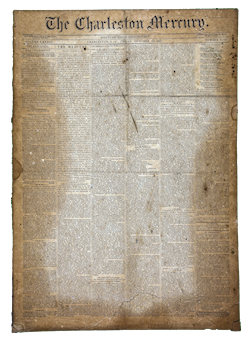June 4, 1863, The Charleston Mercury
We have gathered some additional particulars of the recent destructive Yankee raid along the banks of the Combahee. The latest official despatch from Gen. WALKER, dated Green Pond, eleven o’clock Tuesday night, and which was received here on Wednesday morning, conveyed intelligence that the enemy had entirely disappeared.
It seems that the first landing of the Vandals, whose force consisted mainly of three […..] companies, officered by whites, took place at Field’s Point, on the plantation of Dr. R.L. BAKER, at the mouth of the Combahee River. After destroying the residence and outbuildings, the incendiaries proceeded along the river bank, visiting successively the plantations of Mr. OLIVER MIDDLETON, Mr. ANDREW W. BURNETT, Mr. WM. KIRKLAND, Mr. JOSHUA NICHOLLS, Mr. JAMES PAUL, Mr. MANIGAULT, Mr. CHAS. T. LOWNDES and Mr. WM. C. HEYWARD. After pillaging the premises of these gentlemen, the enemy set fire to the residences, outbuildings and whatever grain, etc., they could find. The last place at which they stopped was the plantation of WM. C. HEYWARD, and, after their work of devastation there had been consummated, they destroyed the pontoon bridge at Combahee Ferry. They then drew off, taking with them between 600 and 700 negros, belonging chiefly, as we are informed, to Mr. WM. C. HEYWARD and Mr. C.T. LOWNDES.
The residences on these plantations are located at distances from the river, varying in different cases from one to two miles. On the plantation of Mr. NICHOLLS between 8000 and 10,000 bushels of rice were destroyed. Besides his residence and outbuildings, which were burned, he lost a choice library of rare books, valued at $10,000. Several overseers are missing, and it is supposed that they are in the hands of the enemy.
The success of a marauding expedition of this character is certainly a very mortifying circumstance. We are informed that Tar Bluff, down the river, below the plantation of Mr. BURNETT, commands the Combahee, and that a few well served guns at that point would prevent gunboats from going up the river. And in like manner it has been suggested that a few guns, skilfully managed, if placed at Chapman’s Fort, on the Ashepoo River, would prevent any ascent of the stream. It is a matter of regret the troops recently stationed between the Combahee and the Ashepoo are ignorant of the localities and roads in an important region, in which it is so difficult to give warning of the enemy’s approach, and where rapidity of movement is so important an element of military success.
